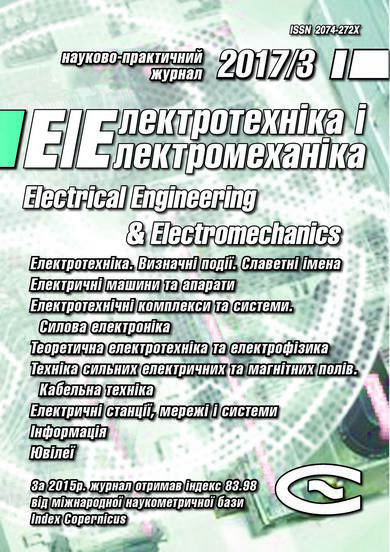MODELING OF AN ADVANCED HEAT EXCHANGE UNIT WITH MICROCHANNELS FOR A COMBINED PHOTOENERGY SYSTEM
DOI:
https://doi.org/10.20998/2074-272X.2017.3.08Keywords:
heat exchanger unit, coolant, solar panels, combined photoenergy systemAbstract
Purpose. Mathematical modeling of the heat exchange unit main parameters for photoenergy system based on general models with forced circulation of heat transfer fluid. Methodology. To determine the coefficient of heat transfer at a given coolant temperature and surfaces temperature necessary to determine the temperature gradient in the wall of the heat exchanger. Temperature gradients can be determined by solving the equation of energy, which depends on the distribution of the flow rate in the flow. In general, a solution of convective heat transfer fluid to flow along the plane comes to solution of the system of differential equations. Results. In the paper features of the selection of theoretical basis and mathematical modeling of thermal processes in the heat exchange unit for combination photoenergy system are presented. As a result of the simulation conducted we improve and develop high-efficiency heat exchange unit with microchannels. Testing of the proposed unit proved its high efficiency through the implementation of turbulent flow of coolant with heat transfer coefficient at 18 kW/(m2×K). Analytical testing of the heat exchanger allowed showing that heat exchanger unit provides a stable operating temperature at less than 50 °C with the coolant flow rate is less than 0.3 m/s. Originality. Novelty of the proposed heat exchanger is in the optimal design of microchannels to improve the heat transfer coefficient. Practical value. The use of this heat exchanger will improve the quality and uniformity of cooling solar panels and reduce energy costs for circulation of fluid.References
1. Jones A.D., Underwood C.P. A thermal model for photovoltaic systems. Solar Energy, 2001, vol.70, iss.4, pp. 349-359. doi: 10.1016/S0038-092X(00)00149-3.
2. Tuomiranta A., Marpu P., Munawwar S., Ghedira H. Validation of thermal models for photovoltaic cells under hot desert climates. Energy Procedia, 2014, vol.57, pp. 136-143. doi: 10.1016/j.egypro.2014.10.017.
3. Sokol E. Rozroblennya fotoenerhetychnoyi ustanovky na osnovi bahatoperekhidnykh kremniyevykh sonyachnykh elementiv z vertykal'nymy diodnymy komirkamy. Zvit pro NDR (zaklyuchnyy; № derzhreyestratsiyi 0111U007628) [Development of the energy picture settings based on multijunction solar cells with silicon-governmental vertical diode cells. Report on R&D (final; state registration number 0111U007628)]. Kharkiv, NTU «KhPI», 2012. (Ukr).
4. Strebkov D.S. Matrichnye solnechnye elementy: Monografija v 3-h tomah. Tom 1 [Matrix solar cells: Monograph in 3 volumes. Vol. 1]. Moscow, GNU VIESH Publ., 2009. 120 p. (Rus).
5. Sokol E.I., Kopach V.R., Zaitsev R.V. Physical and technical features and practical limits of the photonenergy module of the new generation on the territory of Ukraine. Renewable energy, 2011, no.2(25), pp. 18-28. (Rus).
6. Reddy K.S., Premkumar D., Vikram T.S. Heat transfer modeling and analysis of solar thermo-chemical reactor for hydrogen production from water. Energy Procedia, 2014, vol.57, pp. 570-579. doi: 10.1016/j.egypro.2014.10.211.
7. Steinfeld A. Solar thermochemical production of hydrogen – a review. Solar Energy, 2005, vol.78, iss.5, pp. 603-615. doi: 10.1016/j.solener.2003.12.012.
8. Modi A., Buhler F., Andreasen J.G., Haglind F. A review of solar energy based heat and power generation systems. Renewable and Sustainable Energy Reviews, 2017, vol.67, pp. 1047-1064. doi: 10.1016/j.rser.2016.09.075.
9. Isachenko V.P., Osipov V.A., Sukomel A.S. Teploperedacha [Heat transfer]. Moscow, Enegroizdat Publ., 1981. 488 p. (Rus).
10. Mikheyev M.A. Osnovy teploperedachi [Fundamentals of heat transfer]. Moscow-Leningrad: Gosenergoizdat Publ., 1960. 208 p. (Rus).
11. Shokri R., Ghaemi S., Nobes D.S., Sanders R.S. Investigation of particle-laden turbulent pipe flow at high-Reynolds-number using particle image/tracking velocimetry (PIV/PTV). International Journal of Multiphase Flow, 2017, vol.89, pp. 136-149. doi: 10.1016/j.ijmultiphaseflow.2016.06.023.
12. Shirvan K.M., Ellahi R., Mirzakhanlari S., Mamourian M. Enhancement of heat transfer and heat exchanger effectiveness in a double pipe heat exchanger filled with porous media: Numerical simulation and sensitivity analysis of turbulent fluid flow. Applied Thermal Engineering, 2016, vol.109, Part A, pp. 761-774. doi: 10.1016/j.applthermaleng.2016.08.116.
Downloads
Published
How to Cite
Issue
Section
License
Copyright (c) 2017 R. V. Zaitsev

This work is licensed under a Creative Commons Attribution-NonCommercial 4.0 International License.
Authors who publish with this journal agree to the following terms:
1. Authors retain copyright and grant the journal right of first publication with the work simultaneously licensed under a Creative Commons Attribution License that allows others to share the work with an acknowledgement of the work's authorship and initial publication in this journal.
2. Authors are able to enter into separate, additional contractual arrangements for the non-exclusive distribution of the journal's published version of the work (e.g., post it to an institutional repository or publish it in a book), with an acknowledgement of its initial publication in this journal.
3. Authors are permitted and encouraged to post their work online (e.g., in institutional repositories or on their website) prior to and during the submission process, as it can lead to productive exchanges, as well as earlier and greater citation of published work.





